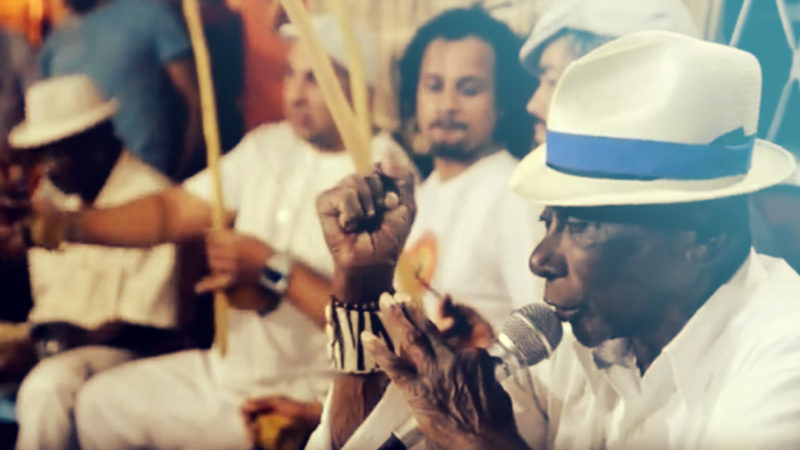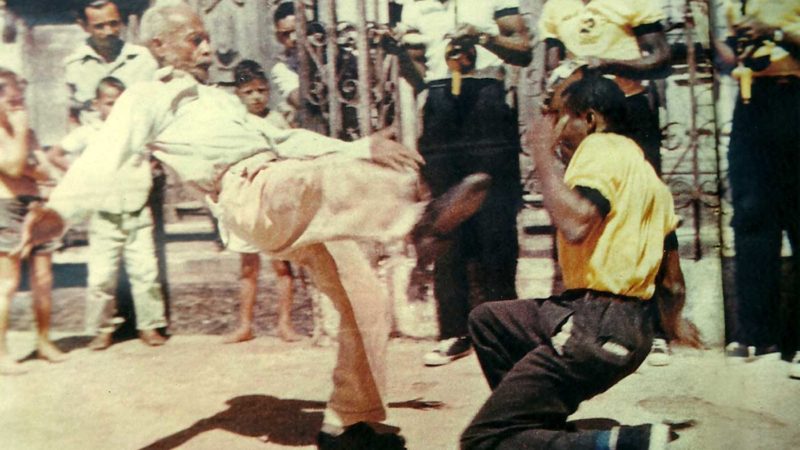A brief description of these 2 very distinct traditions of Capoeira
APANHA LARANJA NO CHAO :
| “Muito usado pelos capoeiristas e Mestres antigos, este toque usava-se para pegar dinheiro na roda, ou seja: em determinado momento, alguns espectadores lançavam notas, no centro da roda, as quais eram reunidas e envoltas em um lenço. Iniciava-se então um jogo manhoso e de muita destreza e malicia na busca de pegar o dinheiro com a boca. Hoje em dia esta prática está em desuso, já que a violência tem prevalecido muitas vezes na Roda de Capoeira.” | Used by many Capoeiristas and old Masters, this rhythm was used to take money in the roda, that is to say: at a certain moment, some spectators threw notes, in the center of the roda, which were gathered and wrapped in a handkerchief. Then a sly game and a lot of dexterity and malice began in the order to pick up the money with the mouth. |
|
A gente ouve falar do toque de Idalina, jogo com navalhas, mas não conhece muito a história. Sabemos que os capoeiras de antigamente não usavam só os pés e as mãos para praticar o que antes era muito mais luta e auto-defesa do que esporte-arte. E também que nessa época valia tudo para fugir dos feitores (época do maculelê com pedaços de pau de cana-de-açúcar) e da polícia (valia tudo: foice, navalha…) e dos outros capoeiristas que apelavam.
A arma branca que a gente mais ouve falar é a navalha. Ela tinha muitos nomes: Naife, Naifa, Sardinha… Os portugueses que a introduziram na capoeira do Rio de Janeiro no século dezenove. Na Bahia, rolava mesmo era a foice. “(…) Os “fadistas” portugueses, sobretudo na cidade de Lisboa, que freqüentavam os bairros tradicionais da Alfama, Mouraria e Madragoa, no início do século passado, eram sujeitos sociais muito próximos aos “capoeiras” do Rio de Janeiro, pois além de freqüentarem os mesmos ambientes: portos, boemia, prostíbulos, botequins, eram também considerados sujeitos marginais que sofriam a dura perseguição da polícia, assim como os capoeiras por aqui. E nesses conflitos com a polícia, e também nas disputas entre os seus próprios pares, a navalha era uma arma que estava sempre à disposição, e não raro, eram responsáveis por graves ferimentos entre esses sujeitos e até morte em muitos casos.” (portal capoeira) Aquele lenço de seda que Mestre Bimba dava para os alunos na formatura não era de enfeite não! O tecido da seda é muito macio e a navalha deslizava nele, protegendo o pescoço da vítima de um golpe mortal. Sabe como ele chamava? ESGUIÃO. Era muito usado na época dos capoeiras clássicos, que se vestiam como sambistas (chapéu de lado, terno branco, sapato bicolor e uma argola na orelha esquerda). Os caras apimentados do Rio de Janeiro, da época do Manduca da Praia, eram feras na navalha. Ainda não sei como foi a importação da navalha para a Bahia. Se alguém souber, me conta. A gente sabe que hoje em dia não se usa mais este tipo de jogo, que é muito perigoso. Mas os grupos mais tradicionais procuram manter a tradição pela cultura e pelos contra-ataques que ainda são eficientes. É só prestar atenção num jogo de angola que volta e meia alguém simula um ataque de navalha ou na “chamada” que a gente revista o camarada. Não custa nada se precaver… |
We hear of the touch of Idalina, play with razors, but do not know much the history. We know that capoeiristas of old used not only their feet and hands to practice what was once much more struggle and self-defense than sport-art. And also that at that time it was worth everything to escape from the overseers (maculele season with pieces of sugar cane) and the police (worth everything: sickle, razor …) and the other capoeiristas who appealed.
The white weapon we most hear about is the razor. She had many names: Naife, Naifa, Sardinha … The Portuguese who introduced her to the capoeira of Rio de Janeiro in the nineteenth century. In Bahia, even the scythe was rolled. “The Portuguese” fadistas “, especially in the city of Lisbon, who frequented the traditional neighborhoods of Alfama, Mouraria and Madragoa, at the beginning of the last century, were social subjects very close to the” capoeiras “of Rio de Janeiro, because in addition to attending the same environments: ports, bohemia, brothels, botequins, were also considered marginal subjects who suffered the harsh persecution of the police, as well as the capoeiras around here. And in these conflicts with the police, and also in the disputes between their own peers, the razor was a weapon that was always available, and not infrequently, were responsible for serious injuries among these subjects and even death in many cases. ” capoeira) That silk scarf that Mestre Bimba gave to the students at graduation was not a garnish! The silk fabric is very soft and the razor slides on it, protecting the victim’s neck from a deadly blow. You know what he called it? ESGUIÃO. It was very used in the time of the classic capoeiras, that dressed like Sambistas (hat of side, white suit, shoe bicolor and a ring in the left ear). The peppery faces of Rio de Janeiro, from the days of Manduca da Praia, were beasts on the razor. I still do not know how the razor was imported into Bahia. If anyone knows, tell me. We know that nowadays this type of game is not used, which is very dangerous. But more traditional groups seek to maintain the tradition of culture and counter-attacks that are still efficient. It is only to pay attention in a game of angola that sometimes someone simulates a knife attack or in the “call” that we reviewed the comrade. It costs nothing to beware … |
original article : http://www.berimbauverde.eco.br/2013/05/idalina-toque-para-jogo-de-navalhas.html
Scroll to top



